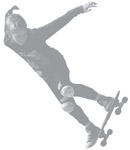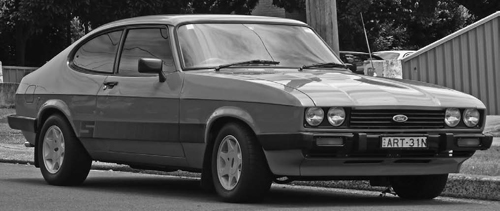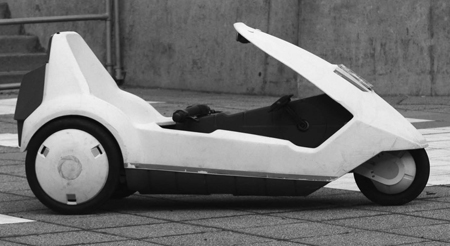A 1980s Childhood (20 page)
Authors: Michael A. Johnson

S
TREET
L
IFE

I’m sure you’ve heard it said before, but whatever happened to white dog poo? Back in the 1980s, every pavement in the country was littered with neat little piles of chalky-white dog poo that was dry and brittle and crunched when you rode over it on your Raleigh Grifter. In those days people fed their dogs bones which contained a high dose of calcium, causing the dogs’ poos to be white. Today’s dog poos aren’t white and neither are they crunchy and brittle. They’re brown and stinky and, quite frankly, they’re just not the same. I miss white dog poo.
But it’s not just the white dog poos I miss, because virtually every area of our lives was different back in the eighties – some things for the better and some for the worse. Apart from fashion, music and TV, we drove different cars, ate different food, shopped at different shops and even decorated our houses differently. The way we spent our leisure time was different, the way we worked was different and even the way we thought was different. I miss it all but I’m not sure I want it all back since I quite like the future, too. If only there was some way of time-travelling so we could go and visit the eighties from time to time.
Well, just imagine for a moment that we’ve managed to borrow Doc Brown’s time-travelling DeLorean from
Back to the Future
because we’re going to take a trip back in time to see how different life really was in the 1980s. I’ve set the flux capacitor to 3 July 1985 (the date
Back to the Future
was released) and I’m going to take you back to the town where I grew up.
On arriving in a blaze of fire in the sleepy Dorset town where I spent my childhood, probably the first difference you would notice is the other cars on the road around you. The majority of cars being driven in the eighties were angular in design and, in my opinion, singularly unattractive having lost some of the pioneering passion and charm of earlier motoring years and now embraced utilitarian and cost-saving designs well suited to modern mass production. This was a time when Skoda was the laughing stock of the automotive world and some of the most popular car colours included rust-brown, mustard-yellow and just plain old beige. And, of course, not everyone had new cars so there was also a significant proportion of clapped-out 1970s cars still on the road.
Not
all the cars were hideous and there were a number of notable exceptions such as the lovely Lamborghini Countach, the fabulous Ferrari Testarossa and the pretty Porsche 959. These cars were so outstandingly beautiful that virtually every young boy in the country had a poster of at least one of them on his bedroom wall; and in extreme cases of limited space, people actually removed their ‘tennis girl scratching her bum’ poster and replaced it with a picture of a red Ferrari Testarossa. In a rather serendipitous turn of events, the designs of the most popular super cars at the time perfectly complimented the eighties decor of many boys’ bedrooms, with their use of striking colours (mainly red, yellow, black or white) and geometric designs that reflected the angular shapes found in the wallpaper patterns.

A splendid example of a Ford Capri S coupe.
(Courtesy of OSX/Wikimedia Commons)
While some truly astounding cars were being made and sold to yuppies in the eighties, it was actually very rare to see one in the flesh. In everyday driving you were much more likely to pass a slurry-brown Rover 2000 driven by an old man with just his hat visible above the steering wheel than you were to encounter a James Bond type driving an amphibious Lotus Esprit like the one in
The Spy Who Loved Me
.
If you could see the cars my neighbours drove in the eighties you would see a motley collection of Montegos, Ford Cortinas, Austin Metros, one red Triumph Dolomite and a Rover Princess. In my parents’ driveway you would see a sky-blue Datsun Cherry that smelled funny and made me feel carsick, and if my medallion-wearing, hairy-chested next-door neighbour was at home, you would see a bright orange Ford Capri complete with furry dice and a musical Dixie horn like they had in the
Dukes of Hazzard
.
One of our elderly neighbours decided that, instead of having a car, he would join the 17,000 other people in the country who had bought a Sinclair C5, believing it to be a practical and cost-efficient alternative for short journeys. In reality, the C5 was nothing more than a battery-assisted recumbent tricycle dressed with a futuristic-looking plastic outer case; but Clive Sinclair, the inventor, declared that it was going to revolutionise transport around the world. Since Mr Sinclair was seen as something of a visionary after having brought us the ZX80, ZX81 and ZX Spectrum home computers, many people believed the C5 was the next big thing.
The C5, however, was a commercial disaster and was abandoned just months after its initial launch due to poor sales and design problems. Since the C5 was so low to the ground with an open cockpit, it was badly exposed to the weather and was unusable for much of the year thanks to the good old British weather; and it quickly became apparent that the motor was completely useless on even the slightest incline meaning that it had to be pedalled up hills to avoid the motor overheating. Quite aside from all of this, the C5 looked ridiculous and made
you
look even more ridiculous as you pedalled it furiously up a hill on a busy main road with a stream of angry motorists stuck behind you shouting abuse.

A Sinclair C5 from 1985, just like the one I used to borrow from my elderly neighbour to cruise around the streets in.
(Courtesy of Grant Mitchell/Wikimedia Commons)
Every cloud has a silver lining, though, and my brothers and I were delighted when our disappointed neighbour decided that he wasn’t going to use his C5 after all and offered it to us to play with as a kind of fancy go-kart. Since the C5 had a maximum speed of 15mph, we didn’t need a licence to drive it, so we would spend many happy minutes (not hours, because the battery never lasted that long) whizzing around the quiet residential roads nearby trying in vain to get the C5 to do a wheelie.
On the subject of electric vehicles, a time-traveller to the eighties might also notice what would appear to be a uniformed naval officer driving an open-sided, three-wheeled, battery-powered van, precariously laden with hundreds of bottles of milk. This would be, of course, our local milkman, Barry, who diligently fulfilled the stereotype assigned to milkmen by delivering more than just a bottle of milk to the homes of numerous lonely housewives. Quite why milkmen used to wear uniforms I don’t know, but I suspect it may have been at the request of the housewives.
Now, if you were to drive the DeLorean into town you would notice at once the different face of the high street, which was populated with fondly remembered shops such as Ratner’s the budget jewellers, John Menzies the newsagents, Bejam the frozen food store, Tandy the electrical store, Our Price the record shop, Do It All the DIY shop, Woolworths the general store and The Sweater Shop which sold, erm … sweaters. If you wanted to buy a television you could go to Rumbelows which was very similar to Comet or Currys, and if you couldn’t afford to buy the television outright, you could always rent it, along with a Betamax video recorder, from Radio Rentals next door.
The high street appeared to be thriving, but it was already under threat from the rise of out-of-town supermarkets and popular new shopping centres that housed numerous stores under a single roof. Old Victorian buildings were torn down and replaced with modern concrete shopping centres built in a brutalist style, causing great controversy at the time and still generating an emotional response in many people today. The advantages and attraction of the new shopping centres were obvious, both for shoppers and retailers alike: all the shops were in one place so you didn’t have to walk all over town; there were no roads or cars to worry about; you were protected from the weather and there was plenty of car parking right next to the shops.
The most well known of all the shopping centres was probably the Arndale Centre which was actually a collection of twenty-two different shopping centres across the UK, rather confusingly all called the Arndale Centre. Whenever I hear the name, I remember a sketch from the TV show
A Bit of Fry and Laurie
, where Stephen Fry is looking to buy a get-well-soon card for his wife in a shop where the cards have curiously specific messages. He doesn’t find the card he wants but does find a card with a message that reads, ‘Sorry to hear your teeth fell out in the Arndale Centre, all my love Thomas’.
While the physical structure of the high street was undergoing something of a revolution, another retail revolution was taking place inside the shops as an exciting technology called ‘the barcode’ began to be used more widely. Although the bar code had been invented many years earlier, it wasn’t until the 1970s that it made its debut in the retail environment, and it took many more years before most retailers adopted the system since it required an expensive upgrade to their tills and computer systems. Prior to the bar code retailers used sticky price labels, marking up the price of each Mars Bar individually (10p for a Mars Bar in 1980 incidentally), but this was a laborious process and often led to errors or dishonesty, with customers swapping price stickers around for their own benefit. Most people embraced the new technology, which sped up the process of paying for their goods, but a few conspiracy theorists considered barcodes to be an intrusive surveillance technology and some Christians became concerned when they realised that every barcode contains the number 666, apparently fulfilling the biblical prophecy ‘that no one may buy or sell except one who has the mark or the name of the beast, or the number of his name … His number is 666’.
After having perused the pleasures of the 1980s high street you could wander around one of the many supermarkets or grocery stores of the time, like Safeways, Mainstop, Happy Shopper, Presto or Pricerite, to remind yourself of the different foods we used to eat in the eighties, and the cheesy muzak that the supermarkets played for us while we were doing the shopping. Of course, most of the essentials were just the same as the food we eat today – meat, fish, dairy, vegetables and so on – but with a bit less variety. It would have been quite unusual to see a sweet potato, star fruit or papaya in the shops and you certainly wouldn’t expect to see much in the way of organic produce.
The eighties was a time when we increasingly looked for time-saving, or convenience foods, and we didn’t think so much about what went into the food or what its nutritional value was. There was no labelling on the food to tell you how many calories were in it, no traffic light warnings printed on the pack to show you the fat, sugar and salt content, and even if there had been, we probably wouldn’t have paid much attention. The traditional stay-at-home housewife role was rapidly vanishing and being replaced by the new, power-dressing career women that didn’t have time to cook long-winded roast dinners, opting to use their brand-new, high-speed microwave ovens instead. In some extreme cases, women stopped cooking altogether and it was reported that men had to cook their own dinner.
